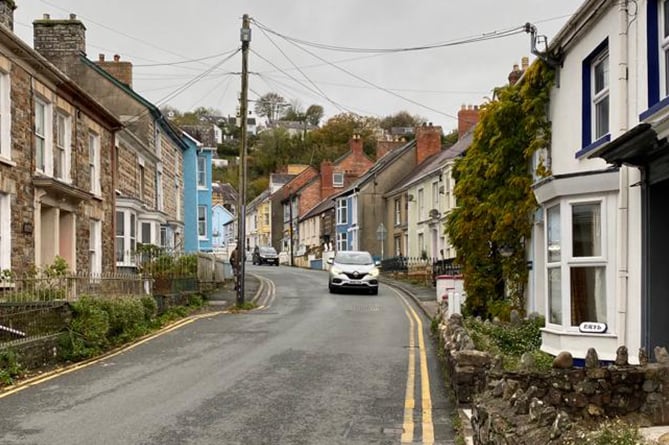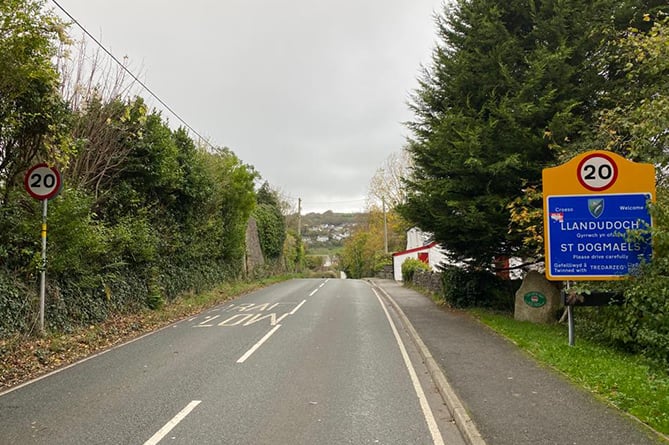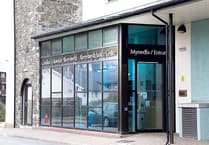Life moves slowly in the village of St Dogmaels. Children walk along the high street on their way home from school. Cyclists pass cautiously, attempting to negotiate the street’s steep incline. And ramblers head up towards the top of the hill, where Pembrokeshire’s famously beautiful coast path begins.
Now even the traffic moves slowly here. And come next September, every residential area in Wales could have to live life at this slower village pace.
St Dogmaels is a testing ground for the new 20mph default speed limit the Welsh Government will introduce in 11 months’ time if all goes to plan.
“It gives the streets back to the community, to our children, pedestrians and cyclists.”
That’s the opinion of village resident Julie Blaisdale, discussing the new 20mph limit with the Cambrian News.
After more than a year of living with the pilot scheme, those who live in St Dogmaels have backed a permanent shift to the lower speed limit.
Campaigners, councillors and residents say it has created a stronger and safer community – despite some opposition from motorists.
The Cambrian News spoke with parents whose children attend the village’s primary school, those with limited mobility, regular cyclists and representatives of the St Dogmaels ‘20 is Plenty’ campaign group.
Their resounding conclusion was that, after the scheme’s introduction, the village has become safer, more tight-knit and increasingly active.
The landmark legislation to change speed limits was passed by the Welsh Government in July and it prompted mixed reactions from the public and opposition from Welsh Conservatives.
Ministers claim the change will reduce accidents, promote sustainable travel and create more active communities.
The government is also considering plans to reduce 40mph roads to 30mph by 2024.
But the Alliance of British Drivers described arguments and data used to reinforce the case for reducing speed limits as ‘propaganda’.
The bartender at the village’s community-owned pub, The White Hart Inn, did say there was a small but vocal minority who opposed the scheme.
He said many feel it is unnecessary and seemed to agree with the ABD that it unfairly penalises drivers.
The St Dogmaels pilot – which will act as a bellwether for other more rural communities – has attracted national and international media attention, with Irish film crews recently descending on the village.
“
It gives the streets back to the community, to kids, to pedestrians, to cyclists.
St Dogmaels resident Julie Blaisdale
Resident Fiona Andrews – who spearheads the village’s 20 is Plenty campaign group – says independent black box recordings show most motorists are now driving close to 20mph on average.
Ms Blaisdale told us that the push for the speed limit change originated during the pandemic.
“One of the upsides of Covid was that we all got to know each other quite well and were more active due to the reduced traffic,” she said.
“People had lost confidence to cycle and allow their children to walk to school alone – but the scheme has changed that.
“There are things councils will need to take on board because you can’t just parachute something like this in and expect it to take off.
“There’s always going to be issues to discuss and it will take a while for people to change their habits.
“But it gives the streets back to the community, to kids, to pedestrians, to cyclists.
“It gets people out, helps with mental health and makes people feel less isolated.”
She referenced the village’s Bike Buddies group, footpath walkers, peddlers and other community groups – with scores of members – who have been lobbying for the scheme.
The county council and the St Dogmaels Community Council were instrumental in securing the pilot, they say.

Stephanie Sullivan, who moved to the village in January 2020 and has sons aged six and nine, said: “It’s been really good for the children’s wellbeing.
“It’s safer for us to let them out, for them to call for their friends and for them to cross the road without us having to worry.
“I’m also finding driving at 20mph feels more natural to me now.”
Jane Bayley, aged 70, said: “I’m a walker and a cyclist and I often pass the narrow roads at the top of the hill which can be too dangerous for riding and walking – and there are no footpaths, which is dodgy for kids going to school.
“Plus with rising fuel prices and obesity problems, surely it makes sense to get people out being active in the fresh air and travelling sustainably.
“Cycling is a dangerous activity in most places and it shouldn’t be.
“Covid and now this has made us a stronger community.”
She added that she was knocked off her bike twice between St Dogmaels and Cardigan before the 20mph limit was introduced.
Another resident Tom Wells, who runs a bike shop in Cardigan, said: “I feel the village is now much more pleasant with a sensible speed limit.
“As I remember, if you insist on driving your car any faster through the village, you would only gain, in theoretically perfect conditions, 37 seconds by travelling at the original 30mph rather than 20mph, and much less than that in real life.
“So, it’s a no-brainer!”
“
There are people very much for it... But there are people – in particular taxi drivers – who hate the idea.
White Hart Inn barman Sam Knight
But bartender Sam Knight told us about some of the conversations she has with patrons of The White Hart Inn.
“It’s mixed. There are people very much for it who want it to be safer and think it’s a good thing,” she said.
“But there are people – in particular taxi drivers – who hate the idea.
“A lot of people say they struggle in their cars with certain hills to keep momentum while going at 20mph.
“Arguments against it are mainly about the fact it slows drivers down, and one guy came in and said that back in his day kids walked around with speed limits at 50mph.”
She added that he agreed more residents are in favour, but the ‘negative people’ are often louder.

Ms Bayley also appealed for the 20mph zone to start further along the high street due to the number of motorists who had been caught with speeding fines despite the wider, safer roads at the top of the hill before you enter the village.
The village’s independent Pembrokeshire county councillor, Mike James, pointed to Living Street’s Walk to School campaign leaderboard for most active pupils in Wales.
St Dogmaels was ranked fifth and, interestingly, featured alongside nine other schools from Cardiff. He said the 20mph speed limit made this possible.
“There is definitely a case that more children are now taking their bikes to school,” he said.
“They’ve got more freedom. Parents have got more confidence.
“St Dogmaels is not built for the 21st century, just like many other Welsh villages.
“And I like to think the scheme has helped everyone of all ages to make the village safer and give people more confidence to walk about.
“There is evidence that some areas are against it. The ones that shout loudest are the ones who are being heard.
“Once those areas get the evidence that we’ve got here, hopefully that will change some people’s minds.”
Funding for Ceredigion council to change speed limits
To change signage across Ceredigion, the Welsh Government has provided nearly £400,000 worth of funding to the county council to change the speed limits of more than 370 locations across the county.
A council spokesperson said: “This is a national initiative by the Welsh Government that Ceredigion County Council as the local highway authority for most roads in Ceredigion, must seek to implement locally, with the Welsh Government itself seeking to make the proposed changes on the A44 and A487 trunk roads.
“Eight pilot 20mph schemes have been introduced across Wales, including at St Dogmaels, Pembrokeshire, and the council understands that the pilot schemes have been generally well received.
“The council is proposing changes to speed limits at approximately 370 locations across Ceredigion, and first stage consultation is underway. It is hoped that the public consultation phase will be held early in 2023.
“The Welsh Government’s intention is for the introduction of all changes to be harmonised nationally in September 2023.”
Wales’ 20mph pilot locations
- Abergavenny, Monmouthshire
- Central North Cardiff
- Severnside, Monmouthshire
- Buckley, Flintshire
- Cilfriw Village, Neath and Port Talbot
- St Dogmaels, Pembrokeshire
- St Brides Major, Vale of Glamorgan
- Llanelli North, Carmarthenshire
When the Welsh Government consulted the public over the proposal, slightly more of those who responded were opposed to the idea than in favour.
A total of 53 per cent of consultation respondents said they were against 20mph (47 per cent ‘strongly against’ and six per cent ‘slightly against’), while 47 per cent were in favour (41 per cent ‘strongly in favour’ and six per cent ‘slightly in favour’).
But in a more representative public opinion survey, over eight in 10 of the public supported a reduction in the speed limit to 20mph.
Deputy Minister for Climate Change Lee Waters said: “Highways authorities are currently preparing for the necessary changes in advance of the 20mph default speed limit on restricted roads coming into force in September 2023.
“The new legislation will not apply a blanket speed limit on all roads, it will simply make the default limit 20mph, leaving local authorities, who know their area best, to engage with the local community to decide which roads should remain at 30mph.
“The Welsh Government has been working closely with highway authorities to design a process for making 30mph exceptions and the exceptions guidance.
“The guidance provides a tool to help apply reasoning for making any exception, whilst also taking into account local factors and circumstances.
“It also ensures a consistent approach is taken across Wales.
“Over the coming months, highway authorities will be consulting on all their proposed exceptions to the new 20mph default speed limit ensuring that local people can have their say on the proposals.”
The number of people who have signed a petition against the change
But Adie Drury, a resident in Buckley, north Wales, which was another of the eight communities where the 20mph speed limit was trialled, set up the petition against the change saying it is causing ‘chaos’ – with vehicles finding it difficult to drive at 20mph on steeper hills.
ABD spokesman Paul Biggs said: “The intensifying war on driving is purely ideological with little or no support from actual facts or data.
“It’s therefore no surprise that policies attacking the UK’s 37 million drivers avoid any proper democratic or consultation processes.”
The ABD points to a consultation which found ‘there is not enough evidence to conclude that there has been a significant change in collisions and casualties following the introduction of 20mph limits in residential areas’ and ‘there has been a small reduction in average (median) speed – less than 1mph.’
More than 45,000 people have signed a petition against the change which will cost the taxpayer more than £32 million.
But a recent report by the Transport Research Institute at Edinburgh Napier University in conjunction with Public Health Wales – commissioned by the Welsh Government – claims the scheme will save about £100m every year due to the reduction in costs associated with road traffic accidents.
Whatever about the statistical analysis, as far as Jane Bayley is concerned, she sees the anecdotal evidence every time she gets on her bike.
“The village community stronger — and safer.”




